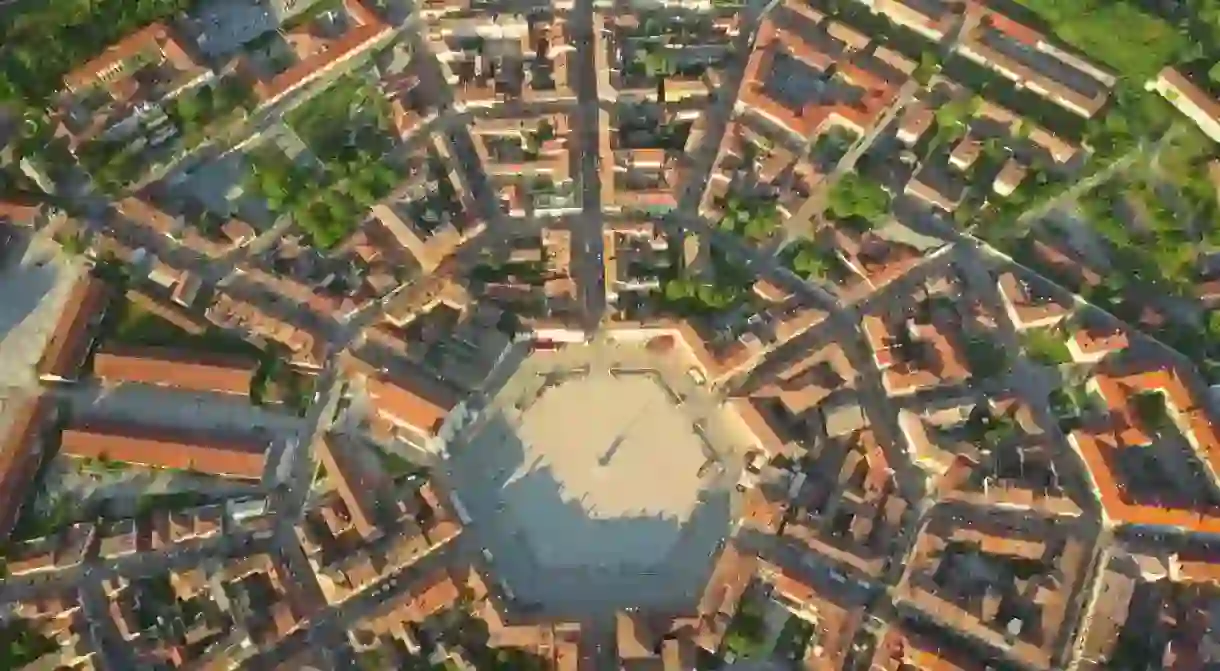8 Underrated Italian UNESCO Sites to Visit Before Everyone Catches On

Stay ahead of the crowd and visit Italy’s beautiful hidden UNESCO gems before everyone catches on. Here we round-up the best ones to visit.
With 54 cultural and natural landmarks on the list, Italy has more UNESCO World Heritage sites than any other country. While most travellers tend to hit the historic centres of Rome and Florence, or the Leaning Tower of Pisa, the lesser-known sites also deserve exploring. Italy’s underrated Italian gems – which include former royal palaces, prehistoric rock carvings and star-shaped towns – provide memorable experiences, which are bound to offer a sense of mystery but without the crowds.
Reggia di Caserta
Building

The Reggia di Caserta is a former royal residence located outside Naples. It’s one of the world’s largest palaces and was built in the 18th century for Charles VII, the Bourbon King of Naples. The Baroque and Neoclassical complex was inspired by the Palace of Versailles and boasts 1,200 rooms across five floors, adorned with elaborate frescoes, gilded decorations and sweeping marble floors. The palace itself is situated in 120 hectares of beautifully-landscaped parkland that features a number of fountains, pools and ornamental statues.
Valle dei Templi
Archaeological site

Castel del Monte
Building

Castel del Monte is certainly not the only castle on Italy’s UNESCO list, but it is the only perfectly octagonal one. Built in the 1240s by Frederick II, the enigmatic fortress was designed with such mathematical and astronomical precision that UNESCO describes it as a ‘unique piece of medieval military architecture’. Lacking traditional features such as a moat or drawbridge, the castle has puzzled historians as to its purpose, with some suggesting it was an elaborate hunting lodge.
Modena Cathedral
Church

Modena’s impressive 12th-century cathedral is a prime example of early Romanesque art. Unusually for this time period, we know the name (though little else) of the architect, Lanfranco, who was celebrated in his time. The façade features reliefs by Wiligelmo, another artist who we know little about, but whose sculptures on both the interior and exterior walls are revered by scholars. The site also includes the cathedral’s annexed bell tower, the Ghirlandina, and the accompanying Piazza Grande.
Crespi d’Adda
Building

The tiny village of Crespi d’Adda is located in Bergamo in Italy’s northern Lombardy region. It was developed by Cristoforo Benigno Crespi in order to house the workers of his textile factory, and is a remarkable example of the ‘company towns’ (self-contained communities) built in Europe and North America by landowners and industrialists in the late 19th century. The town boasted a high standard of living with multi-family residences (each with its own garden), and amenities such as a theatre, sports centre and public wash houses. Today the site is still in good shape thanks to the survival of factory production right up until 2004.
Val Camonica
Natural Feature

Val Camonica, also known as the Camonica Valley, is home to the world’s largest collection of prehistoric petroglyphs. More than 200,000 carvings have been discovered in the region, etched into the rock over a period of around 8,000 years. The drawings offer a glimpse into what life was like for our early ancestors and depict human figures, hunting scenes and even the emergence of the wheel. Val Camonica was Italy’s first UNESCO World Heritage site, added to the list in 1979.
Palmanova
Building

Making the list in 2017, Palmanova is one of Italy’s newest UNESCO sites. The star-shaped fortress town was founded in 1593 and designed to defend against attacks from the Ottoman Empire. The geometrical town exemplifies the defensive works built by the Republic of Venice, also known as the Serenissima, between the 15th and 17th centuries. Five other Venetian structures were jointly added to the list along with Palmanova. These include the island fortress of Peschiera del Garda and the fortified city of Bergamo, as well as three sites in Croatia and Montenegro.
Historic Centre of Urbino
Building

Most visitors looking to explore Italy’s Renaissance heritage head straight to Florence, leaving the hilltop town of Urbino well and truly off the radar. Nevertheless, the picturesque town was a significant centre in the 15th century and attracted artists from across Italy and beyond. Palazzo Ducale is an architectural highlight in itself but, now a museum, it also houses works by Piero della Francesca, Titian and, one of the most celebrated artists of the Renaissance, Raphael.













